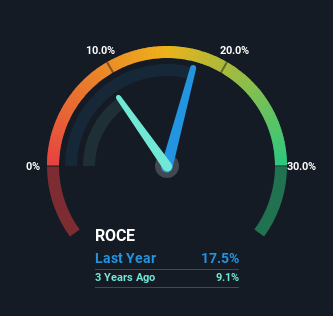- United Kingdom
- /
- Industrials
- /
- AIM:CEPS
CEPS (LON:CEPS) Shareholders Will Want The ROCE Trajectory To Continue

If we want to find a stock that could multiply over the long term, what are the underlying trends we should look for? Firstly, we'd want to identify a growing return on capital employed (ROCE) and then alongside that, an ever-increasing base of capital employed. Put simply, these types of businesses are compounding machines, meaning they are continually reinvesting their earnings at ever-higher rates of return. Speaking of which, we noticed some great changes in CEPS' (LON:CEPS) returns on capital, so let's have a look.
Return On Capital Employed (ROCE): What Is It?
If you haven't worked with ROCE before, it measures the 'return' (pre-tax profit) a company generates from capital employed in its business. Analysts use this formula to calculate it for CEPS:
Return on Capital Employed = Earnings Before Interest and Tax (EBIT) ÷ (Total Assets - Current Liabilities)
0.17 = UK£2.6m ÷ (UK£23m - UK£8.2m) (Based on the trailing twelve months to June 2023).
So, CEPS has an ROCE of 17%. In absolute terms, that's a satisfactory return, but compared to the Industrials industry average of 6.8% it's much better.
Check out our latest analysis for CEPS

While the past is not representative of the future, it can be helpful to know how a company has performed historically, which is why we have this chart above. If you want to delve into the historical earnings , check out these free graphs detailing revenue and cash flow performance of CEPS.
What The Trend Of ROCE Can Tell Us
Investors would be pleased with what's happening at CEPS. The data shows that returns on capital have increased substantially over the last five years to 17%. Basically the business is earning more per dollar of capital invested and in addition to that, 101% more capital is being employed now too. So we're very much inspired by what we're seeing at CEPS thanks to its ability to profitably reinvest capital.
On a related note, the company's ratio of current liabilities to total assets has decreased to 35%, which basically reduces it's funding from the likes of short-term creditors or suppliers. So this improvement in ROCE has come from the business' underlying economics, which is great to see.
Our Take On CEPS' ROCE
A company that is growing its returns on capital and can consistently reinvest in itself is a highly sought after trait, and that's what CEPS has. And since the stock has fallen 34% over the last five years, there might be an opportunity here. That being the case, research into the company's current valuation metrics and future prospects seems fitting.
One final note, you should learn about the 4 warning signs we've spotted with CEPS (including 1 which is concerning) .
For those who like to invest in solid companies, check out this free list of companies with solid balance sheets and high returns on equity.
New: AI Stock Screener & Alerts
Our new AI Stock Screener scans the market every day to uncover opportunities.
• Dividend Powerhouses (3%+ Yield)
• Undervalued Small Caps with Insider Buying
• High growth Tech and AI Companies
Or build your own from over 50 metrics.
Have feedback on this article? Concerned about the content? Get in touch with us directly. Alternatively, email editorial-team (at) simplywallst.com.
This article by Simply Wall St is general in nature. We provide commentary based on historical data and analyst forecasts only using an unbiased methodology and our articles are not intended to be financial advice. It does not constitute a recommendation to buy or sell any stock, and does not take account of your objectives, or your financial situation. We aim to bring you long-term focused analysis driven by fundamental data. Note that our analysis may not factor in the latest price-sensitive company announcements or qualitative material. Simply Wall St has no position in any stocks mentioned.
About AIM:CEPS
CEPS
Operates as an industrial trading holding company in the United Kingdom, rest of Europe, and internationally.
Good value with mediocre balance sheet.
Market Insights
Community Narratives




